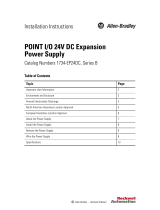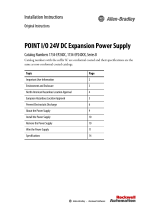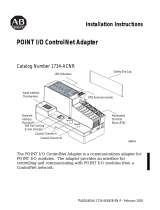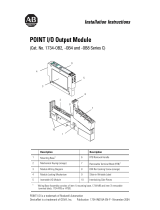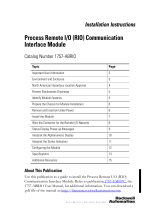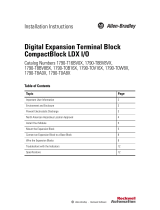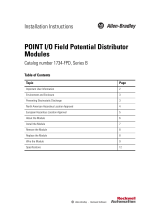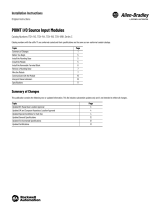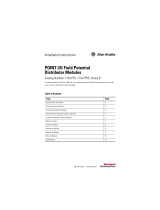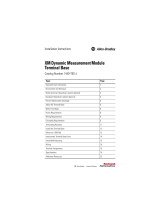La page est en cours de chargement...

Installation Instructions
POINT I/O DeviceNet Communication
Interface Module
Catalog Number 1734-PDN, Series B
Table of Contents
Topic Page
Important User Information 2
Environment and Enclosure 3
Preventing Electrostatic Discharge 3
North American Hazardous Location Approval 4
European Hazardous Location Approval 5
Identify Module Components 6
Install the Module 7
Install the Module in an Existing System 8
Wire the Module 9
Troubleshoot with Indicators 12
Specifications 13

2 POINT I/O DeviceNet Communication Interface Module
Publication 1734-IN057E-EN-E - October 2015
Important User Information
Solid-state equipment has operational characteristics differing from those of electromechanical
equipment. Safety Guidelines for the Application, Installation and Maintenance of Solid State Controls
(Publication SGI-1.1
available from your local Rockwell Automation sales office or online at
http://www.rockwellautomation.com/literature/
) describes some important differences between
solid-state equipment and hard-wired electromechanical devices. Because of this difference, and also
because of the wide variety of uses for solid-state equipment, all persons responsible for applying this
equipment must satisfy themselves that each intended application of this equipment is acceptable.
In no event will Rockwell Automation, Inc. be responsible or liable for indirect or consequential damages
resulting from the use or application of this equipment.
The examples and diagrams in this manual are included solely for illustrative purposes. Because of the
many variables and requirements associated with any particular installation, Rockwell Automation, Inc.
cannot assume responsibility or liability for actual use based on the examples and diagrams.
No patent liability is assumed by Rockwell Automation, Inc. with respect to use of information, circuits,
equipment, or software described in this manual.
Reproduction of the contents of this manual, in whole or in part, without written permission of Rockwell
Automation, Inc., is prohibited.
Throughout this manual, when necessary, we use notes to make you aware of safety considerations.
WARNING: Identifies information about practices or circumstances that can cause an
explosion in a hazardous environment, which may lead to personal injury or death,
property damage, or economic loss.
ATTENTION: Identifies information about practices or circumstances that can lead to
personal injury or death, property damage, or economic loss. Attentions help you
identify a hazard, avoid a hazard and recognize the consequences.
SHOCK HAZARD: Labels may be on or inside the equipment (for example, drive or
motor) to alert people that dangerous voltage may be present.
BURN HAZARD: Labels may be on or inside the equipment (for example, drive or
motor) to alert people that surfaces may reach dangerous temperatures.
IMPORTANT Identifies information that is critical for successful application and understanding of
the product.

POINT I/O DeviceNet Communication Interface Module 3
Publication 1734-IN057E-EN-E - October 2015
Environment and Enclosure
Preventing Electrostatic Discharge
ATTENTION: This equipment is intended for use in a Pollution Degree 2
industrial environment, in overvoltage Category II applications (as defined in IEC
publication 60664-1), at altitudes up to 2000 meters without derating.
This equipment is not intended for use in residential environments and may not
provide adequate protection to radio communication services in such
environments.
This equipment is considered Group 1, Class A industrial equipment according
to IEC/CISPR Publication 11. Without appropriate precautions, there may be
potential difficulties ensuring electromagnetic compatibility in other
environments due to conducted as well as radiated disturbance.
This equipment is supplied as “open type” equipment. It must be mounted
within an enclosure that is suitably designed for those specific environmental
conditions that will be present and appropriately designed to prevent personal
injury resulting from accessibility to live parts. The interior of the enclosure
must be accessible only by the use of a tool. Subsequent sections of this
publication may contain additional information regarding specific enclosure type
ratings that are required to comply with certain product safety certifications.
In addition to this publication, see:
• Industrial Automation Wiring and Grounding Guidelines, publication
1770-4.1
, for additional installation requirements.
• NEMA Standard 250 and IEC 60529, as applicable, for explanations of the
degrees of protection provided by enclosures.
ATTENTION: This equipment is sensitive to electrostatic discharge, which can
cause internal damage and affect normal operation. Follow these guidelines
when you handle this equipment:
• Touch a grounded object to discharge potential static.
• Wear an approved grounding wriststrap.
• Do not touch connectors or pins on component boards.
• Do not touch circuit components inside the equipment.
• Use a static-safe workstation, if available.
• Store the equipment in appropriate static-safe packaging when not in use.

4 POINT I/O DeviceNet Communication Interface Module
Publication 1734-IN057E-EN-E - October 2015
North American Hazardous Location Approval
ATTENTION: This product is grounded through the DIN rail to chassis ground.
Use zinc plated yellow-chromate steel DIN rail to assure proper grounding. The
use of other DIN rail materials (for example, aluminum or plastic) that can
corrode, oxidize, or are poor conductors, can result in improper or intermittent
grounding. Secure DIN rail to mounting surface approximately every 200 mm
(7.8 in.) and use end-anchors appropriately.
The following information applies when
operating this equipment in hazardous
locations:
Informations sur l'utilisation de cet équipement
en environnements dangereux:
Products marked "CL I, DIV 2, GP A, B, C, D" are suitable
for use in Class I Division 2 Groups A, B, C, D, Hazardous
Locations and nonhazardous locations only. Each product
is supplied with markings on the rating nameplate
indicating the hazardous location temperature code.
When combining products within a system, the most
adverse temperature code (lowest "T" number) may be
used to help determine the overall temperature code of
the system. Combinations of equipment in your system
are subject to investigation by the local Authority Having
Jurisdiction at the time of installation.
Les produits marqués "CL I, DIV 2, GP A, B, C, D" ne conviennent
qu'à une utilisation en environnements de Classe I Division 2
Groupes A, B, C, D dangereux et non dangereux. Chaque produit
est livré avec des marquages sur sa plaque d'identification qui
indiquent le code de température pour les environnements
dangereux. Lorsque plusieurs produits sont combinés dans un
système, le code de température le plus défavorable (code de
température le plus faible) peut être utilisé pour déterminer le
code de température global du système. Les combinaisons
d'équipements dans le système sont sujettes à inspection par
les autorités locales qualifiées au moment de l'installation.
EXPLOSION HAZARD
• Do not disconnect equipment unless
power has been removed or the area is
known to be nonhazardous.
• Do not disconnect connections to this
equipment unless power has been
removed or the area is known to be
nonhazardous. Secure any external
connections that mate to this equipment
by using screws, sliding latches,
threaded connectors, or other means
provided with this product.
• Substitution of components may impair
suitability for Class I, Division 2.
• If this product contains batteries, they
must only be changed in an area known
to be nonhazardous.
RISQUE D’EXPLOSION
• Couper le courant ou s'assurer que
l'environnement est classé non dangereux
avant de débrancher l'équipement.
• Couper le courant ou s'assurer que
l'environnement est classé non dangereux
avant de débrancher les connecteurs. Fixer
tous les connecteurs externes reliés à cet
équipement à l'aide de vis, loquets
coulissants, connecteurs filetés ou autres
moyens fournis avec ce produit.
• La substitution de composants peut rendre cet
équipement inadapté à une utilisation en
environnement de Classe I, Division 2.
• S'assurer que l'environnement est classé non
dangereux avant de changer les piles.

POINT I/O DeviceNet Communication Interface Module 5
Publication 1734-IN057E-EN-E - October 2015
European Hazardous Location Approval
The following applies when the product bears the Ex Marking
This equipment is intended for use in potentially explosive atmospheres as defined by
European Union Directive 94/9/EC.
DEMKO certifies that this equipment has been found to comply with the Essential Health
and Safety Requirements relating to the design and construction of Category 3 equipment
intended for use in Zone 2 potentially explosive atmospheres, given in Annex II to this
Directive.
Compliance with the Essential Health and Safety Requirements has been assured by
compliance with EN 60079-0:2012+A11:2013, EN 60079-15:2010, reference certificate
number DEMKO 04ATEX0330347X.
ATTENTION: This equipment is not resistant to sunlight or other sources of
UV radiation.
WARNING: This equipment shall be mounted in an ATEX certified enclosure
with a minimum ingress protection rating of at least IP54 (as defined in
IEC60529) and used in an environment of not more than Pollution Degree 2 (as
defined in IEC 60664-1) when applied in Zone 2 environments. The enclosure
must utilize a tool removable cover or door.
WARNING: This equipment shall be used within its specified ratings defined
by Rockwell Automation.
WARNING: Provision shall be made to prevent the rated voltage from being
exceeded by transient disturbances of more than 140% of the rated voltage
when applied in Zone 2 environments.
WARNING: The secondary of a current transformer shall not be
open-circuited when applied in Class I, Zone 2 environments.
WARNING: This equipment must be used only with ATEX certified Rockwell
Automation backplanes
WARNING: Secure any external connections that mate to this equipment by
using screws, sliding latches, threaded connectors, or other means provided
with this product.
WARNING: Do not disconnect equipment unless power has been removed or
the area is known to be nonhazardous.

6 POINT I/O DeviceNet Communication Interface Module
Publication 1734-IN057E-EN-E - October 2015
Identify Module Components
Use the figure to identify the external features of the module.
POINT I/O DeviceNet Communication Interface Module
Module Description
Description Description
1 DeviceNet Connector 6 DIN Rail Locking Screw Orange
2 Module Label 7 Safety End Cap
3 Interlocking Side Pieces 8 RTB Removable Handle
4 System Power Indicator 9 Removable Terminal Block (RTB)
5 DeviceNet Power Indicator
31538-M
1
9
2
3
4
5
6
7
8

POINT I/O DeviceNet Communication Interface Module 7
Publication 1734-IN057E-EN-E - October 2015
Install the Module
To install the module on the DIN rail, proceed as follows.
1. Position the module vertically above the DIN rail
2. Press down firmly to install the module on the DIN rail.
The locking mechanism will lock the module to the DIN rail.
3. Remove the safety end cap by sliding it up to expose the backplane and power
interconnections.
ATTENTION: When you insert or remove the module while backplane power is
on, an electrical arc can occur. This could cause an explosion in hazardous
location installations.
Be sure that power is removed or the area is nonhazardous before proceeding.
Repeated electrical arcing causes excessive wear to contacts on both the
module and its mating connector. Worn contacts may create electrical
resistance that can affect module operation.
ATTENTION: Do not discard the end cap. Use this end cap to cover the exposed
interconnections on the last mounting base on the DIN rail. Failure to do so
could result in equipment damage or injury from electric shock.

8 POINT I/O DeviceNet Communication Interface Module
Publication 1734-IN057E-EN-E - October 2015
Install the Module in an Existing System
To install a replacement module in an existing system, proceed as follows.
1. To remove the module from the DIN rail, pull up on the RTB removal handle to
remove the terminal block.
2. Use a small-bladed screwdriver to rotate the DIN rail locking screw to a vertical
position. This releases the locking mechanism.
3. Lift straight up to remove.
4. Position the module vertically above the DIN rail.
5. Slide the module down so that the interlocking side pieces engage the adjacent
module.
6. Press firmly to seat the module on the DIN rail.
The module locking mechanism will snap into place.
WARNING: When you connect or disconnect the Removable Terminal Block
(RTB) with field side power applied, an electrical arc can occur. This could cause
an explosion in hazardous location installations.
Be sure that power is removed or the area is nonhazardous before proceeding.

POINT I/O DeviceNet Communication Interface Module 9
Publication 1734-IN057E-EN-E - October 2015
Wire the Module
WARNING: If you connect or disconnect wiring while the field-side power is
on, an electrical arc can occur. This could cause an explosion in hazardous
location installations. Be sure that power is removed or the area is
nonhazardous before proceeding.
NC = No Connection
CHAS GND = Chassis Ground
C = Common
V = Supply
DeviceNet Power
42513
System Power
DeviceNet Connector
NC
CHAS GND
C
V
NC
CHAS GND
C
V

10 POINT I/O DeviceNet Communication Interface Module
Publication 1734-IN057E-EN-E - October 2015
Connect Terminal In Terminal Out
+V DC 6 7
-V DC 4 5
Chas Gnd 2 3
12/24V DC becomes the internal field-power bus for modules to the right.
NC NC
C
VV
C
CHAS
GND
V DC
Connect this supply
to the internal
field-power bus.
43960
12/24V DC Wiring
NC = No Connection CHAS GND = Chassis Ground
C = Common V = Supply
3
5
7
01
2
4
6
12/24V DC
Power
CHAS
GND

POINT I/O DeviceNet Communication Interface Module 11
Publication 1734-IN057E-EN-E - October 2015
Connect Terminal In Terminal Out
L1 6 7
L2/N 4 5
Chas Gnd 2 3
120/240V AC becomes the internal field-power bus for modules to the right.
NC NC
L2/N
L1 L1
V AC
Connect this supply to
the internal field-power
bus.
43961
120/240V AC Wiring
NC = No Connection
L2/N = Neutral, L1 = 120/240V AC
CHAS GND = Chassis Ground
3
5
7
01
2
4
6
120/240V AC
CHAS
GND
CHAS
GND
L2/N
42514
DeviceNet
Connection
Black
Blue
Bare
White
Red
-V
CAN - Low
Shield
CAN - High
+V
1
2
3
4
5
DeviceNet Wiring

12 POINT I/O DeviceNet Communication Interface Module
Publication 1734-IN057E-EN-E - October 2015
Troubleshoot with Indicators
Use the status indicators to troubleshoot your module.
Indicator Indication Probable Cause
System Power Off Not active
DeviceNet power is off or
DC-DC converter problem.
Green System power is on.
DC-DC converter is active (5V).
DeviceNet Power Off Not active
DeviceNet power is OFF.
Green Power is on with 24V present.
System Power
DeviceNet Power
41970

POINT I/O DeviceNet Communication Interface Module 13
Publication 1734-IN057E-EN-E - October 2015
Specifications
Communication Interface Specifications
Attribute Value
Expansion I/O Capacity Up to 17 modules, dependent on backplane bus current draw
(17 times 75mA = 1.275A, just under the limit of 1.3A)
The actual number of modules can vary.
Add up the current requirements of the modules you want to
use to make sure they do not exceed the amperage limit of the
1734-PDN module.
Cat. No. POINTBus Current Requirements
1734-IB2 75mA
1734-IB4 75mA
1734-IB8 75mA
1734-IV2 75mA
1734-IV4 75mA
1734-OB2 75mA
1734-OB4 75mA
1734-OB8 75mA
1734-OB2E 75mA
1734-OB2EP 75mA
1734-OB4E 75mA
1734-OB8E 75mA
1734-OV2E 75mA
1734-OV4E 75mA
1734-OW2 80mA
1734-OW4 80mA
1734-OX2 100mA
1734-IE2C 75mA
1734-OE2C 75mA
1734-IE2V 75mA
1734-OE2V 75mA
1734-IA2 75mA
1734-IM2 75mA
1734-OA2 75mA
1734-IJ 160mA
1734-IK 160mA
1734-IR2 220mA
1734-IT2I 175mA
1734-SSI 110mA
1734-232ASC 75mA
1734-VHSC5 180mA
1734-VHSC24 180mA
1734-485ASC 75mA
Communication Rate 125K bit/s (500m maximum)
250K bit/s (250m maximum)
500K bit/s (100m maximum)

14 POINT I/O DeviceNet Communication Interface Module
Publication 1734-IN057E-EN-E - October 2015
DeviceNet Power Requirements 24V DC (+4% = 25V DC max) @ 400mA maximum
DeviceNet Cable Allen-Bradley part number 1485C-P1-Cxxx
Refer to publication NETS-SG001 for more information.
Module Location Starter module - left side of 1734 system
DeviceNet Power Supply Specifications
Attribute Value
Input Voltage Rating 24V DC nominal
Input Voltage Range 11...25V DC DeviceNet specification
Input Overvoltage Protection Reverse polarity protected
Inrush Current 6A for 5ms maximum
Indicators 2 green power supply status indicators:
System Power (POINTBus 5V power)
DeviceNet Power (24V from DeviceNet)
Supply Power and Current Ratings DeviceNet power must be supplied by a Class 2 source
Power Supply User supplied power should be separate from DeviceNetpower
Communication Interface Specifications
Attribute Value

POINT I/O DeviceNet Communication Interface Module 15
Publication 1734-IN057E-EN-E - October 2015
General Specifications
Attribute Value
POINTBus Output Current 1.3A maximum @5V DC +5% (4.75...5.25)
Power Consumption 8.0W @25V DC
Power Dissipation 1.2W maximum @ 25V DC
Thermal Dissipation 4.1 BTU per hour, maximum @ 25V DC
Isolation Voltage
(continuous-voltage withstand rating)
50V continuous
Tested to withstand 2600V DC for 60s
Field Power Bus
Supply Current
Supply Voltage
10A maximum
10...28.8V DC range,
120V AC or 240V AC
Dimensions
Inches
(Millimeters)
3.0H x 1.0W x 5.25L
(76.2H x 25.4W x 133.4L)
Enclosure Type Rating None (open-style)
Wire Size 0.34…2.5 mm² (22…14 AWG) solid or stranded copper wire
rated @ 75 ºC (167 ºF), or greater, 1.2 mm (3/64 in.)
insulation max
Wiring Category
(1)
1 - on signal ports
Terminal Base Screw Torque 0.6 Nm (7 lb-in)
Weight 0.13 kg (0.29 lb)
(1)
Use this Conductor Category information for planning conductor routing. Refer to Industrial Automation Wiring and
Grounding Guidelines, publication 1770-4.1.

16 POINT I/O DeviceNet Communication Interface Module
Publication 1734-IN057E-EN-E - October 2015
Environmental Specifications
Attribute Value
Operating Temperature IEC 60068-2-1 (Test Ad, Operating Cold),
IEC 60068-2-2 (Test Bd, Operating Dry Heat),
IEC 60068-2-14 (Test Nb, Operating Thermal Shock):
-20…55 °C (-4…131 °F)
Storage Temperature IEC 60068-2-1 (Test Ab, Unpackaged Nonoperating Cold),
IEC 60068-2-2 (Test Bb, Unpackaged Nonoperating Dry Heat),
IEC 60068-2-14 (Test Na, Unpackaged Nonoperating Thermal Shock):
-40…85 °C (-40…185 °F)
Relative humidity IEC 60068-2-30 (Test Db, Unpackaged Damp Heat):
5…95% noncondensing
Vibration IEC 60068-2-6 (Test Fc, Operating):
5 g @ 10…500 Hz
Shock, operating IEC60068-2-27 (Test Ea, Unpackaged Shock):
30 g
Shock, nonoperating IEC 60068-2-27 (Test Ea, Unpackaged Shock):
50 g
Emissions CISPR 11: Group 1, Class A
ESD immunity IEC6100-4-2:
6 kV contact discharges
8 kV air discharges
Radiated RF immunity IEC 61000-4-3:
10V/m with 1KHz sine-wave 80%AM from 30MHz...2000MHz
10V/m with 200Hz 50% Pulse 100%AM at 900MHz
10V/m with 200Hz 50% Pulse 100%AM at 1890 MHz
EFT/B immunity IEC 61000-4-4
+4kV at 2.5kHz on power ports
+2kV at 5kHz on communication ports
Surge transient immunity IEC 61000-4-5:
±1 kV line-line (DM) and ±2 kV line-earth (CM) on signal ports
±2 kV line-earth (CM) on shielded ports
Conducted RF immunity IEC61000-4-6:
10 V rms with 1 kHz sine-wave 80% AM @ 150 kHz…80 MHz

POINT I/O DeviceNet Communication Interface Module 17
Publication 1734-IN057E-EN-E - October 2015
Certifications
Certification (when
product is marked)
(1)
Value
c-UL-us UL Listed Industrial Control Equipment, certified for US and Canada.
See UL File E65584.
UL Listed for Class I, Division 2 Group A,B,C,D Hazardous Locations,
certified for U.S. and Canada. See UL File E194810.
CE European Union 89/336/EEC EMC Directive, compliant with:
EN 50082-2; Industrial Immunity
EN 61326; Meas./Control/Lab., Industrial Requirements
EN 61000-6-2; Industrial Immunity
EN 61000-6-4; Industrial Emissions
European Union 72/23/EEC LVD Directive, compliant with:
EN 61131-2; Programmable Controllers
C-Tick Australian Radiocommunications Act, compliant with:
AS/NZS CISPR 11; Industrial Emissions
Ex
European Union 94/9/EC ATEX Directive, compliant with:
EN60079-15: 2010; Potentially Explosive Atmospheres, Protection "n"
EN60079-0:2012+A11: 2013; General Requirements
II 3 G Ex nA IIC T4 Gc
DEMKO 04 ATEX 0330347X
when used at or below 60V AC or 75V DC
ODVA ODVA conformance tested to DeviceNet specifications
(1)
See the Product Certification link at http://www.rockwellautomation.com/products/certification/ for Declaration of
Conformity, Certificates, and other certification details.

Rockwell Automation Support
Rockwell Automation provides technical information on the Web to assist you in using its products. At
http://www.rockwellautomation.com/support/
, you can find technical manuals, a knowledge base of FAQs,
technical and application notes, sample code and links to software service packs, and a MySupport feature
that you can customize to make the best use of these tools.
For an additional level of technical phone support for installation, configuration and troubleshooting, we
offer TechConnect support programs. For more information, contact your local distributor or Rockwell
Automation representative, or visit http://www.rockwellautomation.com/support/
.
Installation Assistance
If you experience a problem within the first 24 hours of installation, please review the information that's
contained in this manual. You can also contact a special Customer Support number for initial help in getting
your product up and running.
New Product Satisfaction Return
Rockwell Automation tests all of its products to ensure that they are fully operational when shipped from
the manufacturing facility. However, if your product is not functioning and needs to be returned, follow
these procedures.
Documentation Feedback
Your comments will help us serve your documentation needs better. If you have any suggestions on how to
improve this document, complete this form, publication RA-DU002
, available at
http://www.rockwellautomation.com/literature/
.
United States or Canada 1.440.646.3434
Outside United States or
Canada
Use the Worldwide Locator at
http://www.rockwellautomation.com/support/americas/phone_en.html
, or
contact your local Rockwell Automation representative.
United States Contact your distributor. You must provide a Customer Support case number
(call the phone number above to obtain one) to your distributor to complete
the return process.
Outside United States Please contact your local Rockwell Automation representative for the return
procedure.
Publication 1734-IN057E-EN-E - October 2015
Supersedes Publication 1734-IN057D-EN-P - April 2005 Copyright © 2015 Rockwell Automation, Inc. All rights reserved.
Allen-Bradley, Rockwell Automation, POINT I/O, and POINTBus are trademarks of Rockwell Automation, Inc.
Trademarks not belonging to Rockwell Automation are property of their respective companies.
/
